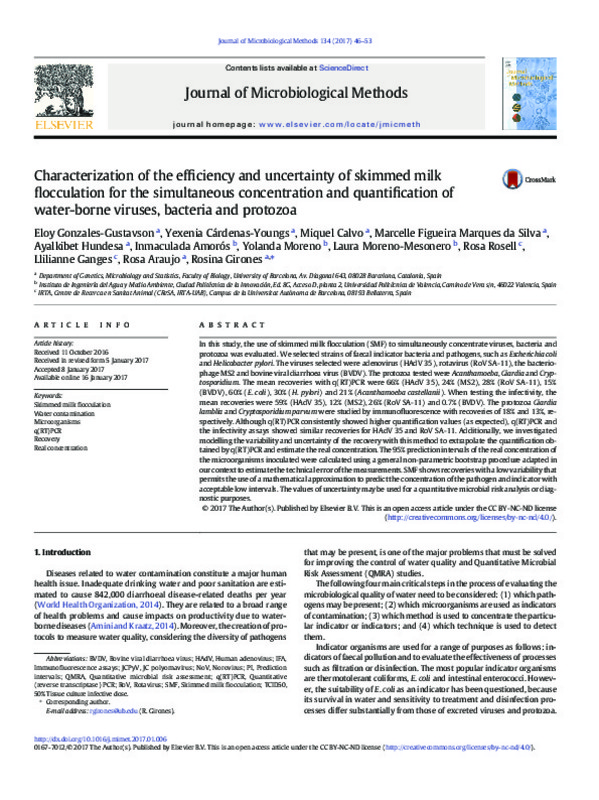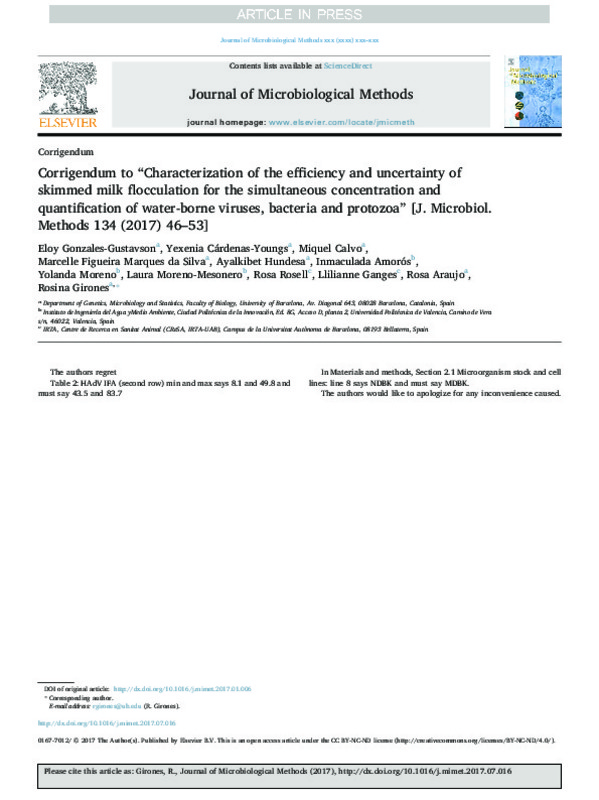JavaScript is disabled for your browser. Some features of this site may not work without it.
Buscar en RiuNet
Listar
Mi cuenta
Estadísticas
Ayuda RiuNet
Admin. UPV
Characterization of the efficiency and uncertainty of skimmed milk flocculation for the simultaneous concentration and quantification of water-borne viruses, bacteria and protozoa
Mostrar el registro sencillo del ítem
Ficheros en el ítem
| dc.contributor.author | Gonzales-Gustavson, Eloy
|
es_ES |
| dc.contributor.author | Cárdenas-Youngs, Yexenia
|
es_ES |
| dc.contributor.author | Calvo, Miquel
|
es_ES |
| dc.contributor.author | Figueira, Marcelle
|
es_ES |
| dc.contributor.author | Hundesa, Ayalkibet
|
es_ES |
| dc.contributor.author | Amoros, Inmaculada
|
es_ES |
| dc.contributor.author | Moreno Trigos, Mª Yolanda
|
es_ES |
| dc.contributor.author | Moreno-Mesonero, Laura
|
es_ES |
| dc.contributor.author | Rosell, Rosa
|
es_ES |
| dc.contributor.author | Ganges, Llilianne
|
es_ES |
| dc.contributor.author | Araujo, R.
|
es_ES |
| dc.contributor.author | Gironés, R.
|
es_ES |
| dc.date.accessioned | 2020-09-08T03:31:49Z | |
| dc.date.available | 2020-09-08T03:31:49Z | |
| dc.date.issued | 2017-03 | es_ES |
| dc.identifier.issn | 0167-7012 | es_ES |
| dc.identifier.uri | http://hdl.handle.net/10251/149536 | |
| dc.description.abstract | [EN] In this study, the use of skimmed milk flocculation (SMF) to simultaneously concentrate viruses, bacteria and protozoa was evaluated. We selected strains of faecal indicator bacteria and pathogens, such as Escherichia coli and Helicobacter pylori. The viruses selected were adenovirus (HAdV 35), rotavirus (RoV SA-11), the bacteriophage MS2 and bovine viral diarrhoea virus (BVDV). The protozoa tested were Acanthamoeba, Giardia and cryptosporidium. The mean recoveries with q(RT)PCR were 66% (HAdV 35), 24% (MS2), 28% (RoV SA-11), 15% (BVDV), 60% (E. coli), 30% (H. pylori) and 21% (Acanthamoeba castellanii). When testing the infectivity, the mean recoveries were 59% (HAdV 35), 12% (MS2), 26% (RoV SA-11) and 0.7% (BVDV). The protozoa Giardia lamblia and Cryptosporidium parvum were studied by immunofluorescence with recoveries of 18% and 13%, respectively. Although q(RT)PCR consistently showed higher quantification values (as expected), q(RT)PCR and the infectivity assays showed similar recoveries for HAdV 35 and RoV SA-11. Additionally, we investigated modelling the variability and uncertainty of the recovery with this method to extrapolate the quantification obtained by q(RT)PCR and estimate the real concentration. The 95% prediction intervals of the real concentration of the microorganisms inoculated were calculated using a general non-parametric bootstrap procedure adapted in our context to estimate the technical error of the measurements. SMF shows recoveries with a low variability that permits the use of a mathematical approximation to predict the concentration of the pathogen and indicator with acceptable low intervals. The values of uncertainty may be used for a quantitative microbial risk analysis or diagnostic purposes. (C) 2017 The Author(s). Published by Elsevier B.V. | es_ES |
| dc.description.sponsorship | This study was funded by the Water Challenges for a Changing World Joint Programming Initiative (W2013-095-C03-01), the Spanish Ministry of Economy and Competitiveness (MINECO - AGL2014-55081-R) and the Grup de Recerca Consolidat: Virus, bacteris i protozous d'interes en salut publica, aigua y aliments (Generalitat de Catalunya, Virbap - 2014-SGR-914). Eloy Gonzales-Gustavson would like to acknowledge the Presidente de la República scholarship from the Peruvian Government, which supported a PhD grant. | es_ES |
| dc.language | Inglés | es_ES |
| dc.publisher | Elsevier | es_ES |
| dc.relation.ispartof | Journal of Microbiological Methods | es_ES |
| dc.rights | Reconocimiento - No comercial - Sin obra derivada (by-nc-nd) | es_ES |
| dc.subject | Skimmed milk flocculation | es_ES |
| dc.subject | Water contamination | es_ES |
| dc.subject | Microorganisms | es_ES |
| dc.subject | Q(RT)PCR | es_ES |
| dc.subject | Recovery | es_ES |
| dc.subject | Real concentration | es_ES |
| dc.subject.classification | MICROBIOLOGIA | es_ES |
| dc.title | Characterization of the efficiency and uncertainty of skimmed milk flocculation for the simultaneous concentration and quantification of water-borne viruses, bacteria and protozoa | es_ES |
| dc.type | Artículo | es_ES |
| dc.identifier.doi | 10.1016/j.mimet.2017.01.006 | es_ES |
| dc.relation.projectID | info:eu-repo/grantAgreement/MINECO//AGL2014-55081-R/ES/DETECCION SENSIBLE DE VIRUS TRANSMITIDOS POR ALIMENTOS UTILIZANDO AMPLIFICACION DIRIGIDA Y NGS Y EVALUACION DE LA TRANSMISION Y PATOLOGIA DE LOS VIRUS DNA EXCRETADOS/ | es_ES |
| dc.relation.projectID | info:eu-repo/grantAgreement/Generalitat de Catalunya//2014 SGR 914/ | es_ES |
| dc.relation.projectID | info:eu-repo/grantAgreement/MINECO//JPIW2013-095-C03-02/ES/NUEVOS INSTRUMENTOS MOLECULARES Y DE METAGENOMICA PARA LA IDENTIFICACION Y CONTROL A ESCALA EUROPEA DE CONTAMINANTES MICROBIANOS EMERGENTES EN AGUA DE RIEGO/ | es_ES |
| dc.rights.accessRights | Abierto | es_ES |
| dc.contributor.affiliation | Universitat Politècnica de València. Instituto Universitario de Ingeniería del Agua y del Medio Ambiente - Institut Universitari d'Enginyeria de l'Aigua i Medi Ambient | es_ES |
| dc.description.bibliographicCitation | Gonzales-Gustavson, E.; Cárdenas-Youngs, Y.; Calvo, M.; Figueira, M.; Hundesa, A.; Amoros, I.; Moreno Trigos, MY.... (2017). Characterization of the efficiency and uncertainty of skimmed milk flocculation for the simultaneous concentration and quantification of water-borne viruses, bacteria and protozoa. Journal of Microbiological Methods. 134:46-53. https://doi.org/10.1016/j.mimet.2017.01.006 | es_ES |
| dc.description.accrualMethod | S | es_ES |
| dc.relation.publisherversion | https://doi.org/10.1016/j.mimet.2017.01.006 | es_ES |
| dc.description.upvformatpinicio | 46 | es_ES |
| dc.description.upvformatpfin | 53 | es_ES |
| dc.type.version | info:eu-repo/semantics/publishedVersion | es_ES |
| dc.description.volume | 134 | es_ES |
| dc.identifier.pmid | 28093213 | es_ES |
| dc.relation.pasarela | S\342210 | es_ES |
| dc.contributor.funder | Generalitat de Catalunya | es_ES |
| dc.contributor.funder | Ministerio de Economía y Competitividad | es_ES |









